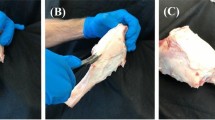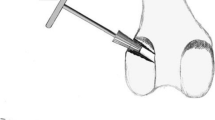Abstract
Purpose
Press-fit fixation of patellar tendon bone anterior cruciate ligament autografts is an interesting technique because no hardware is necessary. To date, no biomechanical data exist describing an implant-free double-bundle press-fit procedure. The purpose of this study was to characterize the biomechanical properties of three double-bundle press-fit fixations.
Methods
In a controlled laboratory study, the patellar-, quadriceps- and hamstring tendons of 10 human cadavers (age: 49.2 ± 18.5 years) were used. An inside out press-fit fixation with a knot in the semitendinosus and gracilis tendons (SG) combined with an additional bone block, with two quadriceps tendon bone block grafts (QU) was compared with press-fit fixation of two bone patellar tendon bone block (PT) grafts in 30 porcine femora. Constructs were cyclically stretched and then loaded until failure. Maximum load to failure, stiffness and elongation during failure testing and cyclical loading were investigated.
Results
The maximum load to failure was 703 ± 136 N for SG fixation, 632 ± 130 N for QU and 656 ± 127 N for PT fixation. Stiffness of the constructs averaged 138 ± 26 N/mm for SG, 159 ± 74 N/mm for QU, and 154 ± 50 N/mm for PT fixation. Elongation during initial cyclical loading was 1.2 ± 1.4 mm for SG, 2.0 ± 1.4 mm for QU, and 1.0 ± 0.6 mm for PT (significantly larger for PT and QU between the first 5 cycles compared with cycles 15–20th, P < 0.01).
Conclusion
All investigated double-bundle fixation techniques were equal in terms of maximum load to failure, stiffness, and elongation. Unlike with single-bundle press-fit fixation techniques that have been published, no difference was observed between pure tendon combined with an additional bone block and tendon bone grafts. All techniques exhibited larger elongation during initial cyclical loading. All three press-fit fixation techniques that were investigated exhibit comparable biomechanical properties. Preconditioning of the constructs is critical.






Similar content being viewed by others
References
Adam F, Pape D, Steimer O, Kohn D, Rupp S (2001) Biomechanical properties of interference screw implantation in replacement of the anterior cruciate ligament with patellar and hamstring transplants. An experimental study using roentgen stereometry analysis (RSA). Orthopaede 30:649–657
Aune AK, Ekeland A, Cawley PW (1998) Interference screw fixation of hamstring vs. patellar tendon grafts for anterior cruciate ligament reconstruction. Knee Surg Sports Traumatol Arthrosc 6:99–102
Boszotta H (1997) Arthroscopic anterior cruciate ligament reconstruction using a patellar tendon graft in press-fit technique: surgical technique and follow-up. Arthroscopy 13:332–339
Clatworthy MG, Annear P, Bulow JU, Bartlett RJ (1999) Tunnel widening in anterior cruciate ligament reconstruction: a prospective evaluation of hamstring and patella tendon grafts. Knee Surg Sports Traumatol Arthrosc 7:138–145
Cooley VJ, Deffner KT, Rosenberg TD (2001) Quadrupled semitendinosus anterior cruciate ligament reconstruction: 5-year results in patients without meniscus loss. Arthroscopy 17(8):795–800
Drogset JO, Grøntvedt T, Myhr G (2006) Magnetic resonance imaging analysis of bioabsorbable interference screws used for fixation of bone patellar tendon bone autografts in endoscopic reconstruction of the anterior cruciate ligament. Am J Sports Med 34:1164–1169
Drogset JO, Strand T, Uppheim G, Odegård B, Bøe A, Grøntvedt T (2009) Autologous patellar tendon and quadrupled hamstring grafts in anterior cruciate ligament reconstruction: a prospective randomized multicenter review of different fixation methods. Knee Surg Sports Traumatol Arthrosc. doi:10.1007/s00167-009-0996-5 (in press)
Felmet G (2010) Implant-free press-fit fixation for bone-patellar tendon-bone ACL reconstruction: 10-year results. Arch Orthop Trau Surg. doi:10.1007/s00402-010-1050-2 (in press)
Fink C, Zapp M, Benedetto KP, Hackl W, Hoser C, Rieger M (2001) Tibial tunnel enlargement following anterior cruciate ligament reconstruction with patellar tendon autograft. Arthroscopy 17:138–143
Freedman KB, D’amato MJ, Nedeff DD, Kaz A, Bach BR Jr (2003) Arthroscopic anterior cruciate ligament reconstruction: a metaanalysis comparing patellar tendon and hamstring tendon autografts. Am J Sports Med 31:2–11
Hefzy MS, Grood ES, Noyes FR (1989) Factors affecting the region of most isometric femoral attachments: part II: the anterior cruciate ligament. Am J Sports Med 17:208–216
Hertel P, Behrend H, Cierpinski T, Musahl V, Widjaja G (2005) ACL reconstruction using bone-patellar tendon-bone press-fit fixation: 10-year clinical results. Knee Surg Sports Traumatol Arthrosc 13:248–255
Hoffmann RF, Peine R, Bail HJ, Südkamp NP, Weiler A (1999) Initial fixation strength of modified patellar tendon grafts for anatomic fixation in anterior cruciate ligament reconstruction. Arthroscopy 15:392–399
Höher J, Möller HD, Fu FH (1998) Bone tunnel enlargement after anterior cruciate ligament reconstruction: fact or fiction? Knee Surg Sports Traumatol Arthrosc 6:231–240
Horan RL, Toponarski I, Boepple HE, Weitzel PP, Richmond JC, Altman GH (2009) Design and characterization of a scaffold for anterior cruciate ligament engineering. J Knee Surg 22:82–92
Jagodzinski M, Behfar V, Hurschler C, Albrecht K, Krettek C, Bosch U (2004) Femoral press-fit fixation of the hamstring tendons for anterior cruciate ligament reconstruction. Am J Sports Med 32:1723–1730
Jagodzinski M, Geiges B, Von Falck C, Knobloch K, Haasper C, Brand J, Hankemeier S, Krettek C, Meller R (2010) Biodegradable screw versus a press-fit bone plug fixation for hamstring anterior cruciate ligament reconstruction. Am J Sports Med 38:501–508
Jansson KA, Harilainen A, Sandelin J, Karjalainen PT, Aronen HJ, Tallroth K (1999) Bone tunnel enlargement after anterior cruciate ligament reconstruction with the hamstring autograft and endobutton fixation technique. A clinical, radiographic and magnetic resonance imaging study with 2 years follow-up. Knee Surg Sports Traumatol Arthrosc 7:290–295
Kartus J, Movin T, Karlsson J (2001) Donor-site morbidity and anterior knee problems after anterior cruciate ligament reconstruction using autografts. Arthroscopy 17:971–980
Kilger RH, Thomas M, Hanford S, Alaseirlis DA, Paessler HH, Woo SL (2005) The effectiveness of reconstruction of the anterior cruciate ligament using the novel knot/press-fit technique. Am J Sports Med 33:856–863
Kousa P, Järvinen TL, Vihavainen M, Kannus P, Järvinen M (2003) The fixation strength of six hamstring tendon graft fixation devices in anterior cruciate ligament reconstruction part II: the tibial site. Am J Sports Med 31:182–188
Kousa P, Järvinen TL, Pohjonen T, Kannus P, Kotikoski M, Järvinen M (1995) Fixation strength of a biodegradable screw in anterior cruciate ligament reconstruction. J Bone Joint Surg Br 77:901–905
Kousa P, Järvinen TL, Vihavainen M, Kannus P, Järvinen M (2003) The fixation strength of six hamstring tendon graft fixation devices in anterior cruciate ligament reconstruction: part I: femoral site. Am J Sports Med 31:174–181
Kurosaka M, Yoshiya S, Andrish JT (1987) A biomechanical comparison of different surgical techniques of graft fixation in anterior cruciate ligament reconstruction. Am J Sports Med 15:225–229
Markolf KL, Hame S, Hunter DM, Oakes DA, Zoric B, Gause P, Finerman GAM (2006) Effects of femoral tunnel placement on knee laxity and forces in an anterior cruciate ligament graft. J Orthop Res 20:1016–1024
Monaco E, Labianca L, Speranza A, Agrò AM, Camillieri G, Díarrigo C, Ferretti A (2010) Biomechanical evaluation of different anterior cruciate ligament fixation techniques for hamstring graft. J Orthop Sci 15:125–131
Mott HW (1983) Semitendinosus anatomic reconstruction for cruciate ligament insufficiency. Clin Orthop Relat Res 172:90–92
Musahl V, Abramowitch SD, Gabriel MT, Debski RE, Hertel P, Fu FH, Woo SL (2003) Tensile properties of an anterior cruciate ligament graft after bone-patellar tendon-bone press-fit fixation. Knee Surg Sports Traumatol Arthrosc 11:68–74
Noyes FR, Barber-Westin SD (2001) Revision anterior cruciate surgery with use of bone-patellar tendon-bone autogenous grafts. J Bone Joint Surg 83:1131–1143
Odensten M, Gillquist J (1986) A modified technique for anterior cruciate ligament (ACL) surgery using a new drill guide for isometric positioning of the ACL. Clin Orthop Relat Res 213:154–158
Paesler HH, Thermann H (2002) Neue Techniken Kniechirurgie. Steinkopff-Verlag Darmstadt
Paessler HH (1995) Anatomical reconstruction of the anterior cruciate ligament with a patellar tendon autograft using a miniarthrotomy technique. Surgical technology international III. Universal Medical, San Francisco, pp 563–570
Paessler HH, Mastrokalos DS (2003) Anterior cruciate ligament reconstruction using semitendinosus and gracilis tendons, bone patellar tendon, or quadriceps tendongraft with press-fit fixation without hardware. A new and innovative procedure. Orthop Clin North Am 34:49–64
Pinczewski LA, Lyman J, Salmon LJ, Russell VJ, Roe J, Linklater J (2007) A 10-year comparison of anterior cruciate ligament reconstructions with hamstring tendon and patellar tendon autograft. Am J Sports Med 35:564–574
Pombo MW, Shen W, Fu FH (2008) Anatomic double-bundle anterior cruciate ligament reconstruction: where are we today? Arthroscopy 24:1168–1177
Rosenberg TD, Deffner KT (1997) ACL reconstruction: semitendinosus tendon is the graft of choice. Orthopedics 20:396–398
Seil R, Rupp S, Krauss PW, Benz A, Kohn DM (1998) Comparison of initial fixation strength between biodegradable and metallic interference screws and a press-fit fixation technique in a porcine model. Am J Sports Med 26:815–819
Tejwani SG, Shen W, Fu FH (2007) Soft tissue allograft and double-bundle reconstruction. Clin Sports Med 26:639–660
Webster KE, Feller JA, Hameister KA (2001) Bone tunnel enlargement following anterior cruciate ligament reconstruction: a randomised comparison of hamstring and patellar tendon grafts with 2-year follow-up. Knee Surg Sports Traumatol Arthrosc 9:86–91
Weiler A, Hoffmann RF, Stähelin AC, Bail HJ, Siepe CJ, Südkamp NP (1998) Hamstring tendon fixation using interference screws: a biomechanical study in calf tibial bone. Arthroscopy 14:29–37
Weiler A, Hoffmann RF, Bail HJ, Rehm O, Südkamp NP (2002) Tendon healing in a bone tunnel. Part II: histologic analysis after biodegradable interference fit fixation in a model of anterior cruciate ligament reconstruction in sheep. Arthroscopy 18:124–135
Woo SL, Fisher MB (2009) Evaluation of knee stability with use of a robotic system. J Bone Joint Surg 91:78–84
Zantop T, Diermann N, Schumacher T, Schanz S, Fu FH, Petersen W (2008) Anatomical and nonanatomical double-bundle anterior cruciate ligament reconstruction. Am J Sports Med 36:678–685
Acknowledgments
We thank Mr. Reinhold Krentscher from the Institut of Legal Medicine for his help.
Conflict of interest statement
The authors declare that they have no conflict of interest.
Author information
Authors and Affiliations
Corresponding author
Rights and permissions
About this article
Cite this article
Ettinger, M., Haasper, C., Hankemeier, S. et al. Biomechanical characterization of double-bundle femoral press-fit fixation techniques. Knee Surg Sports Traumatol Arthrosc 19, 363–371 (2011). https://doi.org/10.1007/s00167-010-1214-1
Received:
Accepted:
Published:
Issue Date:
DOI: https://doi.org/10.1007/s00167-010-1214-1




